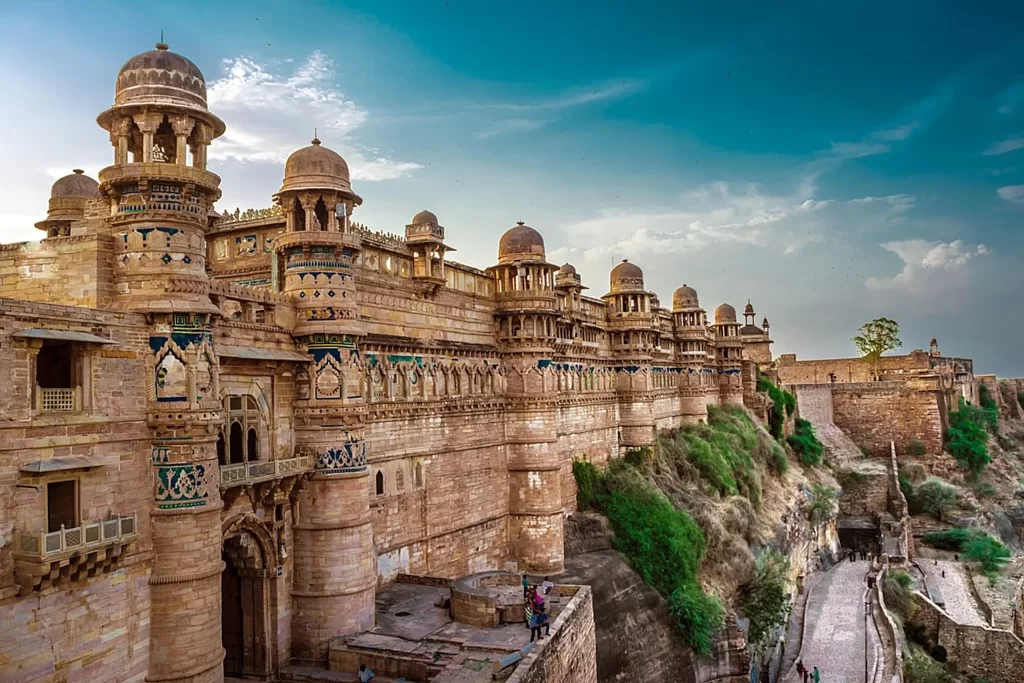Search
CTRL+K
Search
CTRL+K

About Gwalior Fort
Gwalior Fort: A Rich History Spanning Over a Thousand Years
Gwalior Fort, also known as Gwalior Qila, is a historic hill fort located in the city of Gwalior in the Indian state of Madhya Pradesh. The fort has existed for over a thousand years and has been controlled by several different rulers throughout its history. The fort is not just a testament to the architectural prowess of the past, but also a witness to the many battles and political upheavals that shaped the Indian subcontinent.
The exact period of Gwalior Fort’s construction is not certain. According to a local legend, it was built by a local king named Suraj Sen in 3 CE. He was cured of leprosy when a sage named Gwalipa offered him water from a sacred pond, which now lies within the fort. The grateful king constructed a fort and named it after the sage. The sage bestowed the title Pal (“protector”) upon the king and told him that the fort would remain in his family’s possession as long as they bear this title. 83 descendants of Suraj Sen Pal controlled the fort, but the 84th, named Tej Karan, lost it.
The fort has existed since at least the 10th century, and the inscriptions and monuments found within what is now the fort campus indicate that it may have existed as early as the beginning of the 6th century. A Gwalior inscription describes a sun temple built during the reign of the Huna emperor Mihirakula in the 6th century. The Teli ka Mandir, now located within the fort, was built by the Gurjara-Pratiharas in the 9th century. The Kachchhapaghatas controlled the fort in the 10th century, most probably as feudatories of the Chandelas.
From the 11th century onwards, the fort faced several attacks from Muslim dynasties. In 1022 CE, Mahmud of Ghazni besieged the fort for four days. According to Tabaqat-i-Akbari, he lifted the siege in return for a tribute of 35 elephants. The Ghurid general Qutb al-Din Aibak, who later became a ruler of the Delhi Sultanate, captured the fort in 1196 after a long siege. The Delhi Sultanate lost the fort for a short period before it was recaptured by Iltumish in 1232 CE.
In 1398, the fort came under the control of the Tomars. The most distinguished of the Tomar rulers was Maan Singh, who commissioned several monuments within the fort. The Delhi Sultan Sikander Lodi tried to capture the fort in 1505 but was unsuccessful. Another attack, by his son Ibrahim Lodi in 1516, resulted in Maan Singh’s death. The Tomars ultimately surrendered the fort to the Delhi Sultanate after a year-long siege. Within a decade, the Mughal emperor Babur captured the fort from the Delhi Sultanate.
The fort has served as a prison for political prisoners throughout its history. The Mughal emperor Akbar made the fort a prison for political prisoners. For example, Abul-Kasim, son of Kamran and Akbar’s first cousin, was held and executed at the fort. Aurangzeb’s brother, Murad, and nephews Suleman and Sepher Shikoh were also executed at the fort. The killings took place in the Man Mandir palace.
After the death of the Mughal emperor Aurangzeb, the Rana chieftains of Gohad held the Gwalior Fort. The Maratha general Mahadaji Shinde (Scindia) captured the fort from the Gohad Rana Chhatar Singh, but soon lost it to the British East India Company. Daulat Rao Sindhia lost the fort to the British during the Second Anglo-Maratha War.
The fort has witnessed several battles and political upheavals that shaped the Indian subcontinent. During the 1857 uprising, around 6500 sepoys stationed at Gwalior rebelled against the Company rule, although the Company’s vassal ruler Jayaji Scindia remained loyal to the British. The British took control of the fort in June 1858.
By 1886, the British were in complete control of India, and the fort no longer had any strategic importance to them. Therefore, they handed over the fort to the Scindia family. The Scindias continued to rule Gwalior until the independence of India in 1947 and built several monuments, including the Jai Vilas Mahal.
Today, Gwalior Fort is a popular tourist attraction and a UNESCO World Heritage Site. Visitors can explore the fort’s many palaces, temples, and other historical structures. The Gujari Mahal palace, built for Queen Mrignayani, is now an archaeological museum. The fort also houses the second oldest record of “zero” in the world, which was found in a small temple located on the way to the top. The inscription is around 1500 years old.
Gwalior Fort is not just a symbol of India’s rich cultural heritage but also a reminder of the many battles and political struggles that took place on its soil. Its walls have witnessed the rise and fall of many empires and dynasties, making it a must-visit destination for history enthusiasts.
Gwalior Fort is a must-visit place for history buffs and architecture enthusiasts. The fort is home to several monuments that showcase the rich cultural heritage of the region. Some of the must-visit monuments in Gwalior Fort includes the following
Categories & Amenities
Review stats
Excellent0%
Very good0%
Good0%
Fair0%
Poor0%
Reviews




No results available
Reset© Gwalior Plus. All rights reserved.